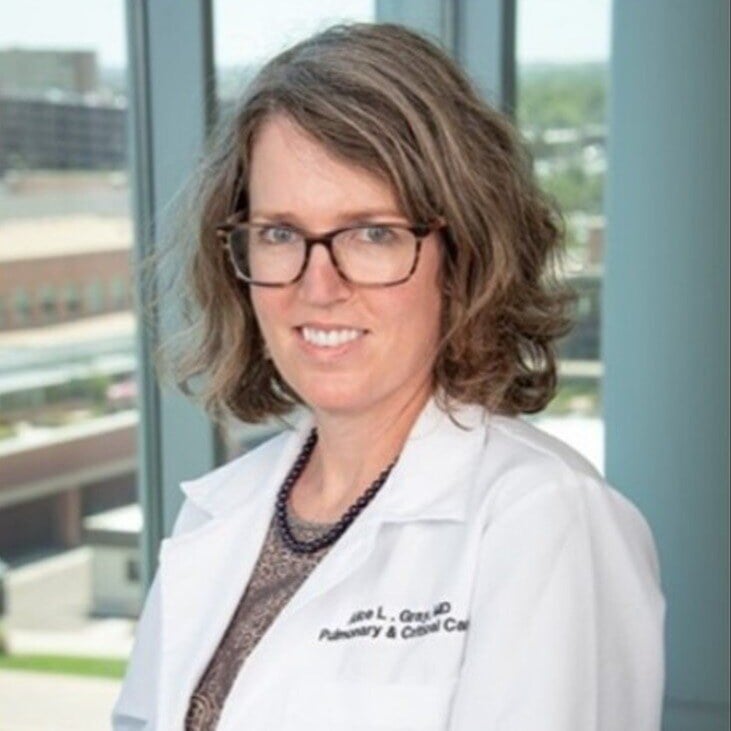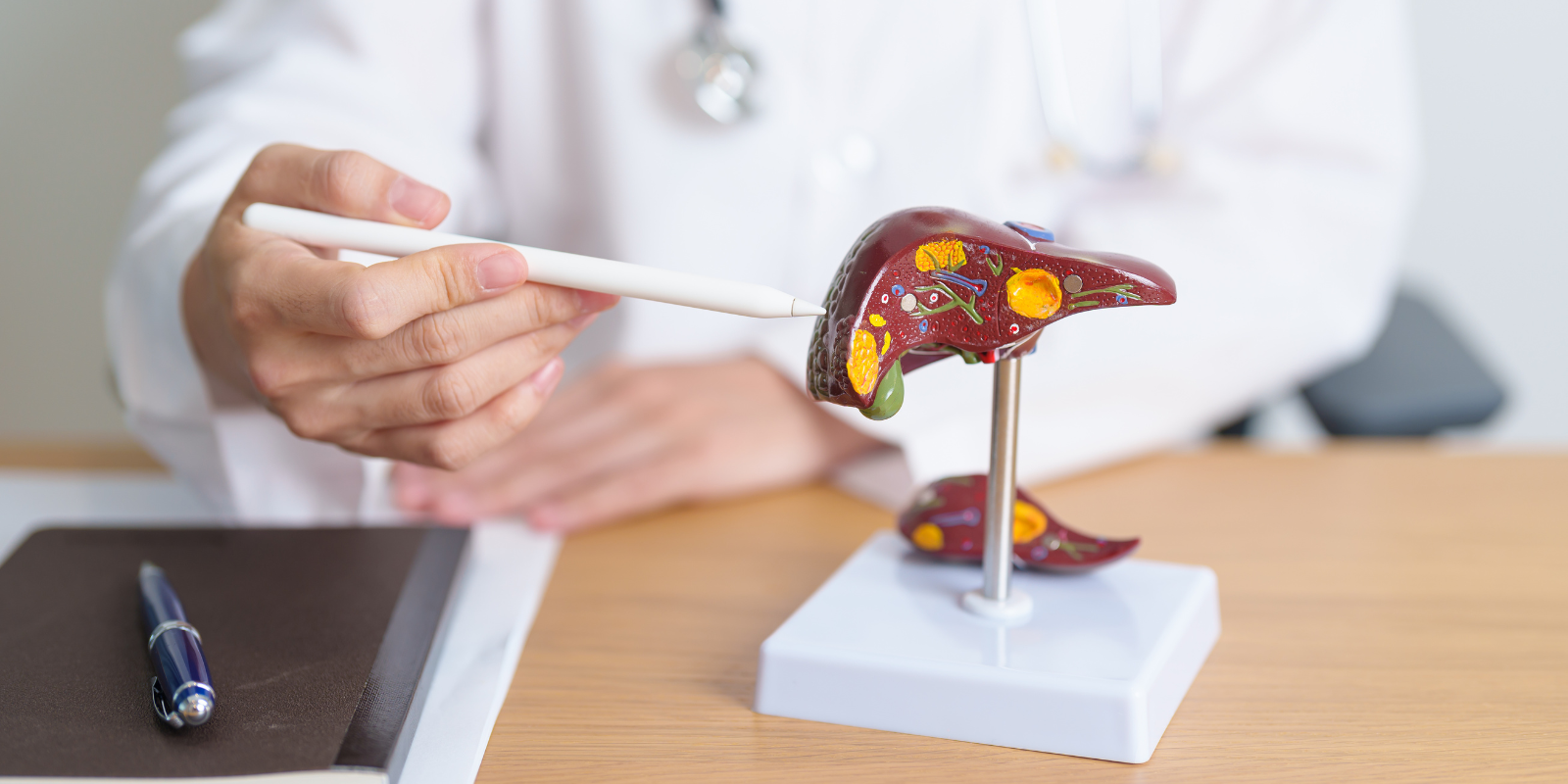As medical director of the only lung transplant program in Colorado, Alice Gray, MD, aims to make the University of Colorado Hospital the best place in the country to get a lung transplant. As part of that mission, she prioritizes delivering exceptional care to her patients, who are often facing the most stressful time of their lives.
“I’ve transplanted people as young as high school kids, and the oldest was 80 years old. You see the whole spectrum of life, and many are scared to death and anxious. You see them at their most vulnerable,” says Gray, an associate professor in the Division of Pulmonary Sciences and Critical Care Medicine at the University of Colorado Department of Medicine. “It’s incredible to know these people from when they’re dying from their lung disease and then to see them get their transplant and get their lives back.”
Gray strives to empower her patients with information about their health issues and treatment options so they can make informed decisions that align with what matters to them. As one patient commented in a survey, “Dr. Gray is a wonderful, caring, and very knowledgeable doctor. She really listens to me and understands my health issues. The best doctor I have ever had.”
It is this people-oriented approach that has led to Gray building a reputation as an exceptional clinician. In recognition of this work, Gray was among the 21 faculty members in the CU Department of Medicine who were inducted into the department’s Clinical Excellence Society,
“Simply put, Dr. Gray is an absolutely superb clinician, with an unparalleled combination of astute clinical judgment, and a wealth of experience and common sense,” wrote Jerry Nick, MD, a professor of pulmonary sciences and critical care medicine and director of the Colorado Adult Cystic Fibrosis Program, in a recommendation letter on Gray’s behalf, adding that he could “think of no other physician more qualified or deserving of this honor.”
“Her excellence in clinical care is inspiring and raises the bar for all of us,” he continued.
Becoming a leader in lung transplant care
Although Gray’s father and grandfather were both physicians, she initially did not foresee a career in medicine. Instead, she decided to get her undergraduate degree in English. But following a series of bad jobs after college, she went back to the drawing board.
“I had to think about: What did I want to do? And science came more naturally to me than my English degree, so I decided to go back to school, take my science classes, and apply to medical school,” Gray says.
She completed a post-baccalaureate premedical program before attending the University of Michigan Medical School. Gray completed her residency and a fellowship program at Duke University.
“What got me interested in pulmonary medicine was that during medical school, I spent about a month working in an outpatient pulmonary clinic and I really liked the physicians I worked with,” she says.
Through her training, she found herself drawn to the lung transplant clinic, and she eventually joined the lung transplant team at Duke.
“When patients come to you and have advanced lung disease, you figure out what you can do for them to make them the best possible candidate for a transplant,” she says. “When the transplant surgery is finished, the surgeons call us, and we meet the patients and evaluate them. Basically, from the minute they wake up from their surgery, we’re back with them, and then we take care of them both in the inpatient and outpatient setting for the rest of their lives.”
 Alice Gray, MD, smiles with her father, Laman A. Gray, Jr., MD, a retired professor of surgery at the University of Louisville.
Alice Gray, MD, smiles with her father, Laman A. Gray, Jr., MD, a retired professor of surgery at the University of Louisville.
There is a special moment that happens between Gray and her patients when they come out of their transplant surgery.
“When they hear your voice, I think it gives them a sense of safety,” she says, adding that there have been moments where patients will squeeze her hand. “You shepherd them through the recovery process, and when things come up, your patient knows they have someone who is involved in their care and knows their story from the beginning to the end.”
While at Duke, Gray became the medical director of the adult cystic fibrosis program and associate medical director of the lung and heart-lung transplant program. After some time, she decided she was ready to progress in her career. In 2018, she joined CU as the medical director of the lung transplant program at the University of Colorado Hospital.
“One of the reasons I came to Colorado is because being here would give me the time to give each patient what they needed,” she says.
Enhancing CU’s lung transplant program
The lung transplant program at CU has existed since 1992, and it is the only lung transplant program in Colorado, serving a large geographic area, Gray explains.
“We take care of people from southern New Mexico to northern Montana,” she says.
When Gray joined the CU program, there were some challenges facing the program, such as staffing. To improve the program, Gray began by assessing what was occurring and the systematic changes she could make.
“You want to make sure you are using objective data and tests, and that you’re utilizing all the expertise of your multidisciplinary team. Ensure it is a collaborative approach and that you’re getting buy-in from everybody,” she says. “It’s a constant work in progress. The hardest part is trying to maintain a culture of positivity and optimism, because that’s not always easy in medicine.”
Gray’s hard work has paid off, as shown by the positive reviews given by patients and other doctors.
“I am very pleased to state that Dr. Gray has succeeded beyond all expectations in resuscitating the UCH Lung Transplant Program, recruiting energetic new faculty, and rebuilding the reputation of the service,” Nick wrote.
In her recommendation letter, Anne Fuhlbrigge, MD, the CU School of Medicine’s senior associate dean for clinical affairs, wrote that Gray’s dedication and leadership has led to “developing a lung transplant program that is a national leader and provides excellent care for every patient.”
David Badesch, MD, director of the Pulmonary Hypertension Center and former interim head of the Division of Pulmonary Sciences and Critical Care Medicine, praised Gray as a leader and program builder in his recommendation letter.
“Speaking from personal experience, as a pulmonary hypertension physician who has shared in the care of complex patients with Dr. Gray, I can state unequivocally that she is thoughtful, thorough, conscientious, and highly dedicated to the wellbeing of her patients,” Badesch wrote.
Aspiring to be the best
Always looking to improve, Gray’s goal is to make the lung transplant program the best in the country. To her, that doesn’t mean the program is serving the most amount of patients but is rather prioritizing the wellbeing of both her team and her patients.
“It means we’re remaining thoughtful about what we’re doing and why. You have to think about how you’re growing, who is on your team, and the resources you have,” she says.
Part of this work includes addressing health disparities, she explains, adding that she wants to help people who are disadvantaged by poverty, structural racism, and other barriers that may affect their ability to get a lung transplant.
“Historically, the vast majority of people who have gotten a lung transplant in the United States have been white — and that is not reflective of the population,” she says. “There are a lot of barriers in terms of getting a transplant because the evaluation process is so rigorous. You have to have the psychosocial and financial resources, and that can make it harder for certain groups of people to qualify for it.”
For instance, a patient could be denied if they do not have access to reliable transportation.
“But now, we’re trying to ask: Is this barrier a fixable thing, and how can we help?” Gray says. “Part of what we are doing is trying to be intentional in recognizing our implicit biases, and we try to help patients navigate the complex health system and give them time to do so, so they can learn how to advocate for themselves.”
“This is something we can and should do. This is something that is worth the time and effort,” she continues.
Prioritizing patients
Hoping to make the world better through her work, Gray carries with her the experiences of serving hundreds of patients over the years — including the people she helped save and the lives lost.
“I remember every single person I’ve lost, and I remember the kindness people have given me,” she says. “It changes your perspective on death, because I’ve witnessed so much of it. It’s always very sad, but it can also be a beautiful transition. And it’ll happen to all of us, so it’s nothing to be afraid of.”
For Gray, the highlights of her career have been the lives she has helped change for the better. The connections she has developed with patients have carried on beyond the hospital doors, with many keeping in touch and sharing photos of their new lives with her. One former patient, for example, has been in Gray’s life since she was a fellow.
“This patient had cystic fibrosis and was pregnant, and she had terrible lung function. She delivered her baby at 24 weeks, and we transplanted her three months later,” Gray says. “Now, she’s actually had three lung transplants. And she would give me her daughter’s hand-me-down clothes to give to my daughter, which is amazing.”
It brings tears to Gray’s eyes to think of the patients who insisted on following her after she left Duke and came to CU, as there were several who insisted on remaining in her care.
“This job has taught me to be grateful for every life experience I get to have, and it has taught me to not sweat the small stuff. It really makes you realize that there are things worth worrying, stressing, or caring about, and there are things to let go,” Gray says. “It’s been a gift for me. I feel really fortunate to have found what is so meaningful.”
.png)



